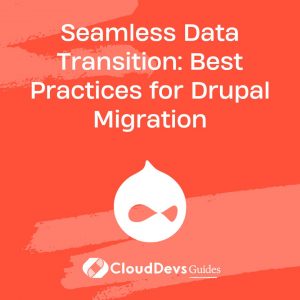Seamless Data Transition: Best Practices for Drupal Migration
Data migration is a crucial part of any website development project, especially when transitioning to a new content management system (CMS) like Drupal. Whether you’re moving from an older version of Drupal or from a different CMS altogether, successful data migration is essential to ensure a smooth transition and maintain data integrity. In this blog post, we’ll explore some best practices for Drupal data migration, along with examples to help you understand the process better.
Why Data Migration Matters
Before diving into best practices, let’s understand why data migration is essential for a Drupal project:
- Preserving Data Integrity: Data migration ensures that your content, user data, and configurations are transferred accurately, preserving data integrity and preventing data loss during the transition.
- Seamless Transition: Proper migration helps maintain website functionality, avoiding downtime or disruption for your users.
- Efficiency: Migrating content manually can be time-consuming and error-prone. Automation through migration tools can save time and reduce the likelihood of mistakes.
- Cost-Effective: Migrating data efficiently can save costs associated with manual data entry or content recreation.
Drupal Data Migration Best Practices
- Planning and Assessment:
Before starting any migration, conduct a thorough assessment of your existing website and data. Identify the content types, taxonomy, and configurations you need to migrate. Create a detailed migration plan outlining the source and destination of data.
Example: If you’re migrating from WordPress to Drupal, identify how WordPress categories will map to Drupal taxonomies and WordPress posts to Drupal nodes.
- Use Migration Modules:
Drupal offers several migration modules, such as Migrate, Migrate Plus, and Migrate Tools, to facilitate data migration. These modules provide a framework for creating migration processes.
Example: You can use the Migrate module to create custom migration scripts, define source and destination plugins, and execute migrations.
3.Data Validation and Transformation:
Ensure data consistency and quality by validating and transforming data during migration. Use Drupal’s data processing capabilities to clean and format data as needed.
Example: When migrating user profiles, you might need to validate email addresses and transform them to match Drupal’s email format.
- Incremental Migration:
For large datasets, consider incremental migration. This approach migrates data in smaller chunks or batches, reducing the risk of errors and improving performance.
Example: Instead of migrating all 10,000 blog posts at once, migrate them in batches of 500.
- Version Control and Testing:
Track your migration code in version control systems like Git. Perform thorough testing to identify and resolve issues before migrating to the production site.
Example: Use Git to track changes in migration scripts, making it easier to collaborate with your team and roll back changes if necessary.
- Logging and Monitoring:
Implement logging and monitoring to keep track of migration progress and detect any errors or anomalies. Drupal’s logging system can help you troubleshoot issues.
Example: Set up a monitoring system to notify you of any migration failures or performance bottlenecks.
7.Backup and Rollback Plan:
Always have a backup of your source data and a rollback plan in case something goes wrong during migration. This ensures you can revert to the previous state if needed.
Example: Create regular backups of your old website and database to avoid data loss.
- Performance Optimization:
Optimize your migration process for better performance. This may include tuning database queries, leveraging caching, and optimizing the server environment.
Example: Configure your server to allocate more resources during migration to speed up the process.
- Security Considerations:
Ensure that sensitive data is handled securely during migration. Implement encryption and access controls to protect user data.
Example: When migrating user accounts, use encryption for passwords to maintain security.
- Documentation:
Document your migration process, including migration scripts, mappings, and configurations. This documentation is invaluable for future reference and troubleshooting.
Example: Create a detailed migration document that outlines each step of the process and includes examples of data mappings.
Conclusion
Drupal data migration is a critical aspect of website development, and following best practices is essential for a successful transition. By planning meticulously, using Drupal migration modules, validating and transforming data, and implementing proper testing and monitoring, you can ensure a smooth and efficient migration process.
Remember that data migration is not a one-time event; it’s an ongoing process. As your website evolves, you may need to update your migration strategies and scripts. With the right approach and best practices in place, you can maintain data integrity and keep your Drupal website running smoothly, ensuring a positive user experience.
Table of Contents








